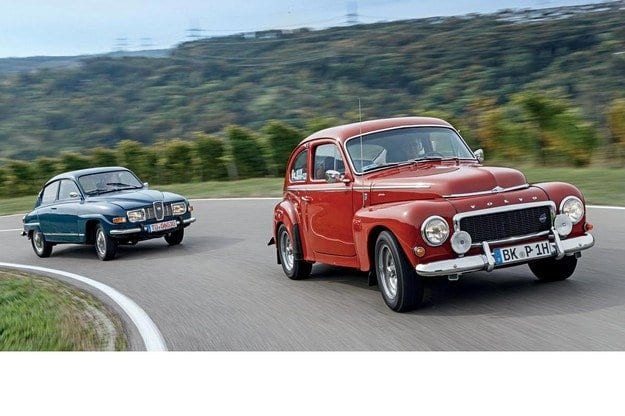
Test drive Saab 96 V4 and Volvo PV 544: Swedish pair

More like new Saab 96 and Volvo PV 544 looked like a veteran car
In addition to the original hull shapes, the common denominator of the two Swedish models is another quality - the reputation of reliable and reliable machines.
It is guaranteed that no one will confuse these classic models with others. In appearance, this Swedish pair has become a truly prominent character in the history of the automotive industry. Only in this form they could remain on the car market for decades. And the most distinctive part of their bodies - the rounded arch of the sloping roof - a legacy from the time of the appearance of these northern relics somewhere in the distant era of the 40s.
We invited a copy of two Swedish classics to the meeting, whose state at the moment could not be different. The Saab 96 is not restored, produced in 1973, while the Volvo PV 544 is not only completely restored but also improved in many of its specific historical details, copied since 1963. As a phenomenon, however, both cars are typical of the existence of such models. as veterans.
The Volvo stands out as a car for active driving. Its owner, who has maintained and driven it for 32 years, for example, installed a modified 20 hp B131 series engine. For safety reasons, the front axle is equipped with disc brakes and brake booster from Volvo Amazon - a modification that many representatives of the "humped Volvo" use. The color also matches the sporty demeanor of the car – it is a typical red PV 544 Sport with color number 46 according to Volvo specification. The first owner in Denmark ordered a white car. By the way, all changes compared to the conditions of purchase were made in the 90s.
30s American style design
Contemporaries of the 50s model were also delighted with the serial Volvo. Even Le Mans winner Paul Frere was a fan: “I have never had a production car with dynamic qualities so strikingly at odds with its down to earth, even old-fashioned appearance,” the driver and test journalist wrote. in 1958 in auto motor and sports. When it was developed in the mid-40s, the two-door body fit perfectly with the tastes of the time - influenced by the ideal of streamlined lines, American design set the fashion for the world. But almost immediately after the first copies of the "humpbacked Volvo" left the factory floor in Gothenburg, a new, simplified "pontoon" line began to appear.
In the beginning, Volvo stuck to a shape with well-defined wings and a rounded back. Judging by the long and successful career of the "rear" series - from the former new to the current classic cars - this has done the model much more good than harm. The involuntary retro design of Edward Lindbergh's team continues to evoke attention and emotion.
Even sports equipment was hidden under the rounded hood in the most expensive versions - the 1965-liter version with 1,8 hp reached the pinnacle of the standard four-cylinder engine in 95. - the same power as then Porsche 356 sc. Volvo maintains the sporty image of its two-door model by participating in many European rallies. "Humpbacked Volvo" with a tuned two-liter engine demonstrates the dynamic characteristics of a modern car. In contrast, the large steering wheel, speedometer belt, long shift lever, and the view of the old-fashioned bodywork through the low windshield make for a basic driving experience.
Swedish aerodynamic line
As Volvo builders end their game of tradition in 1965, 75km north of Gothenburg at Trollhättan, Saab engineers are still thinking about how to extend the life of their classic 96. The aerodynamic base design was developed in the mid-40s . in those years - by Sixten Sasson, who participated in the design team, consisting of 18 people, led by Gunnar Jungström.
The form of futuristic associations was not a tax paid by Saab on the then body fashion, but rather a testament to the confidence of Svenska Aeroplan Aktiebolag (SAAB) as an aircraft manufacturer. Initially, a three-cylinder two-stroke engine modeled on the DKW with a displacement of 764 cm3 was sufficient for the drive role, which in the 1960 model, proposed in 96, received an increased cylinder diameter and a volume of 841 cm3, sufficient for 41 hp. .s. For seven years, Saab has relied on valveless drive. Then even the nobles in Trollhättan realized that their two-stroke engine was already outdated. And with the launch of a larger mid-range model, Saab opted for an economical engine change from Ford.
Since 1967, the odd-looking Swede has been powered by a 1,5-liter V4 engine from the Ford Taunus 12M TS. Power unit with a capacity of 65 hp Originally developed in the United States as a competitor to VW's four-cylinder boxer Turtle, it found use in the Taunus 1962M in 12. However, compared to two-stroke engines, the short and fast-rotating four-stroke engine from Cologne has one disadvantage: it is 60 kg heavier than the two-stroke engine and therefore causes inharmonious behavior on the road. The steering system is particularly heavy at low speeds. In addition, the soft seats have little lateral support. Saab backers were not afraid of such things, however, and the 96 V4 remained in the company's range until 1980.
Original characters
If we compare the production periods, Saab turns out to be a considerably longer distance runner. In turn, Volvo displays a more solid overall design. It is also a larger car, with a more powerful engine, and last but not least, thanks to the rear wheel drive, it also has a sportier character. However, a direct comparison between the two models is not possible, as the red "humpback Volvo" is too far from where it was at the time of purchase. In any case, both Swedes have original characters. Nowadays, when all cars are becoming more and more alike, quirky Scandinavians have a new look. However, it is not only originality that gives them a place in automotive history. They have also earned their fame for many pieces of passive safety equipment such as standard seat belts.
Conclusion
Editor Dirk Johe: The more progressive hull shape speaks in favor of Saab. This is more unusual and less common. However, due to the severe understeer, the front wheel drive model is less fun to drive. Compared to him, the Volvo representative is perceived as more solid and wins my sympathy for a sportier character, not least thanks to the rear wheel drive.
A bit of sports history: drifting as an advertising strategy
Both Saab and Volvo rely on the brilliant success of car racing. Rally is a typical sport for northerners.
■ Winning the Monte Carlo Rally often has more impact than a championship title. Saab driver Eric Carlson even achieved two successes as the king of all rallies - he won races in his two-stroke Saab in 1962 and 1963. This achievement is the crowning achievement of the Swedish brand in motor racing; however, she failed to win the international championship. However, they have many national championships and personal victories throughout Europe.
Even after switching to a four-stroke V4, the success of the Saab 96 continues. In 1968 Finn Simo Lampinen won the RAC Rally in the British Isles with such a car. Three years later, the 24-year-old Swede behind the wheel of the 96th V4, the future world rally champion Stig Blomkvist, called the applause of the public. In 1973, "Master Blomkvist" won the first of his eleven World Rally Championship victories in his home country.
Until 1977, the round four-cylinder Saab competed in the World Rally Championship. It was then replaced by a simple modern 99.
■ Volvo wins two European Championships with PV 544; before the establishment of the World Championship in 1973, it was the highest level rally competition. However, the residents of Gothenburg were unable to win the Monte Carlo Rally. In 1962, when rival Saab won the Monte race for the first time, Volvo created the company's sports division. Its leader is the racer Gunnar Anderson, who in 1958 became the European champion in his "humpbacked Volvo". In 1963, Goy won his second title, and a year later his teammate Tom Trana brought the third championship cup.
Thanks to this, Volvo has already released all of its champion cartridges, but still managed to crown itself with another important success: in 544, pre-owned PV 1965 private drivers Yoginder and Yaswant Singh, two brothers of Indian origin, won the victory. East African safari rally. Racing on rough African paved roads was then considered the most difficult rally in the world. There is no better proof of the reliability and durability of a car than winning the Safari Rally.
Text: Dirk Johe
Photo: Ahim Hartmann

